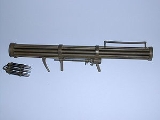
Fliegerfaust
Encyclopedia
The Fliegerfaust also known as the "Luftfaust" (lit. “air fist”), was a prototype unguided German
multi-barreled ground-to-air rocket launcher
designed to destroy enemy ground attack planes.
in 1944, the Luftfaust was produced in two different versions.
The first version, the Fliegerfaust A, had four 20 mm caliber barrels. These fired 20 mm projectiles weighing 90 g and containing 19 g of explosive, propelled by means of a small rocket.
The second version, the Fliegerfaust B ("Luftfaust") increased the length of the barrels, and added another 5 barrels, for a total of 9 barrels. The weapon had a total length of 150 cm and weighed 6.5 kg. The firing sequence was that the first 4 rounds from every second barrel were fired immediately and the remaining five 0.1 second later to avoid damaging the projectiles themselves by the rockets' exhaust fumes and from interfering with their courses. Although some sources state the barrels were fired individually with a delay of 2 seconds between each ignition.
Stabilisation of the rocket in flight was not by means of fins but by four small angled holes drilled around the exhaust venturi the effect of which was to take a small proportion of the rockets thrust and turn it into rotational thrust spinning the missile along its axis, imparting stability through spin, just like rifling in a gun barrel spins the bullet making it more stable in flight.
A six barrel 30 mm prototype was also constructed.
.
However, a 1945 photograph of the Hotel Adlon in Berlin clearly shows at least 3 expended Fliegerfaust B's lying in the rubble. The Adlon sat directly opposite the Brandenburg gate in central Berlin, meaning that issue may have been more widespread than assumed.
Germany
Germany , officially the Federal Republic of Germany , is a federal parliamentary republic in Europe. The country consists of 16 states while the capital and largest city is Berlin. Germany covers an area of 357,021 km2 and has a largely temperate seasonal climate...
multi-barreled ground-to-air rocket launcher
Multiple rocket launcher
A multiple rocket launcher is a type of unguided rocket artillery system. Like other rocket artillery, multiple rocket launchers are less accurate and have a much lower rate of fire than batteries of traditional artillery guns...
designed to destroy enemy ground attack planes.
Overview
Designed by HASAG (Hugo Schneider AG) of LeipzigLeipzig
Leipzig Leipzig has always been a trade city, situated during the time of the Holy Roman Empire at the intersection of the Via Regia and Via Imperii, two important trade routes. At one time, Leipzig was one of the major European centres of learning and culture in fields such as music and publishing...
in 1944, the Luftfaust was produced in two different versions.
The first version, the Fliegerfaust A, had four 20 mm caliber barrels. These fired 20 mm projectiles weighing 90 g and containing 19 g of explosive, propelled by means of a small rocket.
The second version, the Fliegerfaust B ("Luftfaust") increased the length of the barrels, and added another 5 barrels, for a total of 9 barrels. The weapon had a total length of 150 cm and weighed 6.5 kg. The firing sequence was that the first 4 rounds from every second barrel were fired immediately and the remaining five 0.1 second later to avoid damaging the projectiles themselves by the rockets' exhaust fumes and from interfering with their courses. Although some sources state the barrels were fired individually with a delay of 2 seconds between each ignition.
Stabilisation of the rocket in flight was not by means of fins but by four small angled holes drilled around the exhaust venturi the effect of which was to take a small proportion of the rockets thrust and turn it into rotational thrust spinning the missile along its axis, imparting stability through spin, just like rifling in a gun barrel spins the bullet making it more stable in flight.
A six barrel 30 mm prototype was also constructed.
Combat use
The Fliegerfaust was not a successful weapon because of its small effective range caused by too large dispersion of projectiles and the designed range of 500 meters was never attained. Although large orders for the weapon were placed in 1945, and with 10,000 launchers and 4 million rockets ordered, only 80 of these weapons were ever used in combat trials, in this case by a unit based at SaarbrückenSaarbrücken
Saarbrücken is the capital of the state of Saarland in Germany. The city is situated at the heart of a metropolitan area that borders on the west on Dillingen and to the north-east on Neunkirchen, where most of the people of the Saarland live....
.
However, a 1945 photograph of the Hotel Adlon in Berlin clearly shows at least 3 expended Fliegerfaust B's lying in the rubble. The Adlon sat directly opposite the Brandenburg gate in central Berlin, meaning that issue may have been more widespread than assumed.

